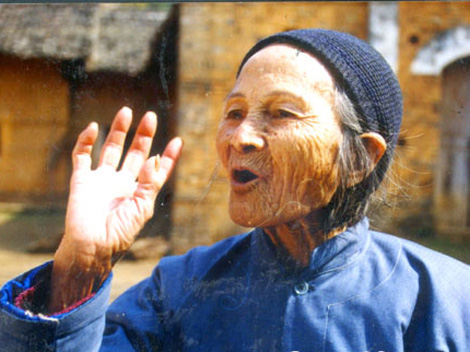
Xingguo County, located in south Jiangxi Province, is governed by Ganzhou City. Over 95% of the population in Xingguo is the descendants of Hakkas that immigrated from the Central Plains. The unique geographical condition and immigration background decide that the Hakkas have been leading a hard life among the mountains and dense woods generation after generation, and they have nothing but the folk song to express their inner feelings in their off-labor time.
Xingguo folk song enjoys a long history, and legend has it that the timberjacks in the Qin Dynasty who left Xingguo for Luoshan Mountain to build the Epang Palace were the first people singing this kind of song. After the Hakkas moved from the Central Plains and inhabited here, the Hakkas' ballad influenced the Xingguo folk song greatly and even integrated to the later. After repeated reforming and evolutions, Xingguo folk song took its root in this mountainous area and even flourished here. The saying that "Starting from the Tang Dynasty, Xingguo folk song flourished in the Song Dynasty and came down to present" is a vivid summary of the afore-said situation.
Xingguo folk song is lively and rich in variety, filled with a vivid life atmosphere. It can be classified to vocal solo, antiphonal singing, "Sandatie" (chorus by three persons), chorus and troll according to the form. But according to the content, it can be classified to Suoge Song (Key-locking song, a kind of antiphonal singing), Douge Song (song competition), Caihua Song (guess riddles by songs), Diuguanyin (guess riddles by songs), Yellow loach tail biting, Xiudalian, Tengchanshu, Shuchanteng (the last four kinds are also songs of unique content) and so on. According to the performance form, Xingguo folk song can be classified to field antiphony, tiaoxi (female wizard dance), folk-custom song, narration song, competition song and others.
The antiphonal song sung in the mountains and fields is also called remote-sing song. Its basic pattern is of four lines and each line has seven characters, but some singers would like to add another line of the same rhyme in the end so as to deepen and supplement the former content, thus it becomes a pattern of five lines, and this variance of the basic pattern is called "Sandieban". Tiaoxi is a kind of folk song often sung within rooms, often called indoor folk songs. They are primarily narrating songs, consisting of song head, song abdomen and song tail, which is of typical traditional characteristic of "topknot, pork stomach and leopard tail".
Both the remote-sing song and indoor song share one common distinctive feature: impromptu singing. The songs are created according to the present scene and environment, and they are sung by the singer extemporaneously. Therefore, the level of the songs depends mainly on the singers' ability of creating and compiling. The first-class singers sometimes are able to make witty remarks and create one climax after another.
In the form of singing, Xingguo folk song has a salient feature different from other folk songs, i.e., Xingguo folk song began with the "Ai-ya-le" (Chinese onomatopoeias) in each sentence, which is filled with forceful sense of music rhythm, and the excited emotions are blurted out; the singing is vigorous and unrestrained, just like water surging forward in a big river. In the middle of the songs, different singers develop their own singing style - some are loud and sonorous and agitated, but some are low and beautiful. The last sentence usually ends in an echoing phrase "darling brother (sister)", and nowadays it has been replaced with "comrade brother (sister)", which echoes with the "Ai-ya-ya" in the beginning, thus forming a singing genre of completeness and uniqueness. The Xingguo folk song covers a wide range of subject matters of life. In the bygone days, apart from love and toil, the content also included historical stories, legends, news and others. Sometimes the song is improvised, but sometimes it is a long song of narration, and it richly varies in form.
Xingguo folk song inherits the traditional creating technique of fu (exposition), bi (comparison) and xing (affective image), and it develops and improves itself in the long history. The reason that Xingguo folk song can last a long vigorous life lies in its local sentiment and mud-flavor. All of the songs are about the daily life of the common people, and they are picked up easily and casually to become songs.